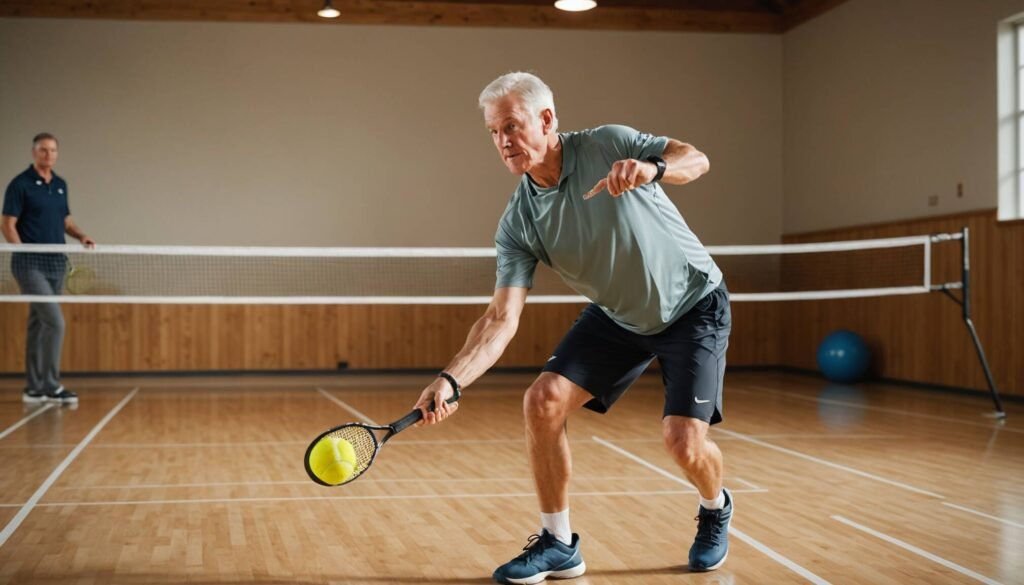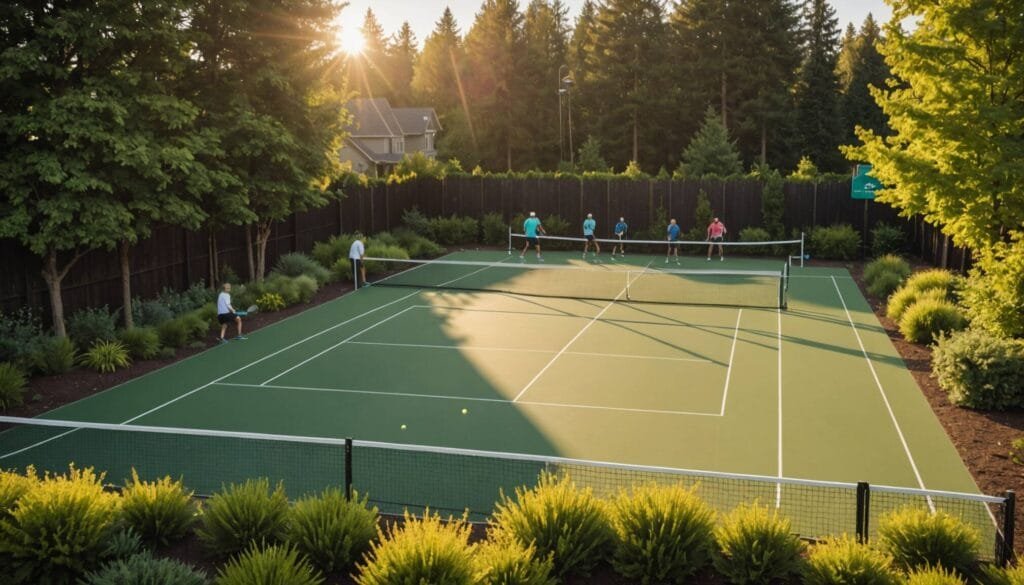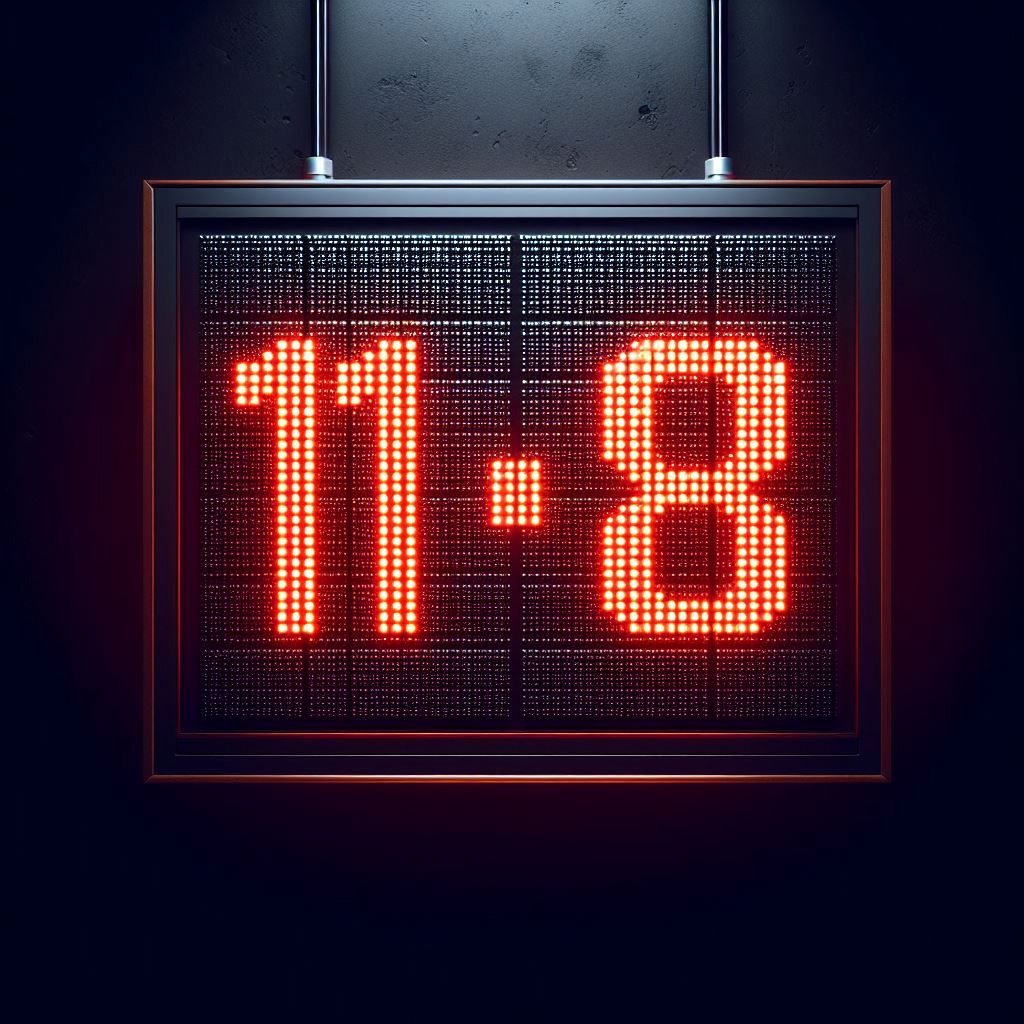How Sitting Neutral Can Transform Your Counters and Chop the Chicken Wing for Good
There’s this moment that happens to almost every pickleball player. You’re at the kitchen line, someone fires a speedup right at your shoulder, and suddenly your arm contorts in a way that looks and feels like you must have just picked up a paddle for the first time. You know the position. The dreaded chicken wing. It’s awkward, it’s weak, and the resulting shot usually ends with the ball either sailing long or dying in the net.
APP pro Jack Munro recently teamed up with up-and-comer Elliott Schupp to break down exactly why this happens and, more importantly, how to fix it. Turns out, it’s all about how you’re positioned before the ball even comes at you. The solution isn’t complicated, but it requires you to rethink one of the most fundamental aspects of your ready position at the kitchen line.
The Problem With Sitting Backhand
Here’s what most amateur players do: they camp out in a backhand-ready position. Their paddle’s already cocked to the left for righties, and they’re committed to hitting everything, and I mean everything, with a backhand counter. If you’ve spent any time watching recreational pickleball, you’ve probably seen this stance repeated on courts across the country. Players stand with their weight shifted slightly to their backhand side, paddle positioned and ready to fire off that backhand volley the moment any ball comes their way.
Munro explains that while this approach has its merits, and there are genuinely some good reasons players adopt it, it creates a massive vulnerability that becomes glaringly obvious the moment a ball gets fired to your forehand side. You don’t have to think when you’re committed to one side, which removes the decision-making element from your game. You can take balls earlier if you slide correctly across your body, getting to speedups before they pass you by. And you eliminate the guesswork that comes with reading which side the ball is going to, since you’ve already decided you’re taking everything with your backhand regardless of where it actually ends up.
But here’s where the strategy falls apart. When that speedup comes to your forehand side and you’re already committed to your backhand position, you’re stuck. Your body is facing the wrong direction, your paddle is on the wrong side, and you have a split second to make something happen. The result is almost always that awkward chicken wing position where your elbow flares out, your wrist breaks in an unnatural angle, and you’re essentially trying to will the ball over the net through sheer hope rather than proper mechanics.
As Munro puts it, if you get jammed in your chicken wing, then you’re just going to pop it up or shank it into the net. And there’s another problem that doesn’t get talked about enough: when you slide to cover that forehand side with your backhand, you’re out of position for the next ball. You’ve essentially given up court positioning to hit a shot that’s already compromised. You might make contact with the ball, but you’ve left a gaping hole in your court coverage, and any decent opponent will exploit that opening on the very next shot.
The Neutral Position Advantage
So what’s the alternative? Sitting neutral. Instead of committing to one side before you even know where the ball is going, you stay balanced in the middle and react to where the ball actually goes. This means you can open up your forehand when the ball comes to that side, turning what would’ve been a weak chicken wing into a legitimate weapon. It’s a simple concept that fundamentally changes how you approach kitchen line exchanges.
Munro explains that now you’re turning a weakness into a strength. Now you have a forehand volley here instead of trying to chicken wing or trying to take it out front with the backhand. The mental shift required here is significant. You’re moving from a defensive, pre-committed stance to an active, responsive position that lets you play offense regardless of where the ball goes.
The benefits stack up quickly when you start implementing a neutral stance. You don’t have to slide and abandon your court position, which means you’re always ready for the next ball. You can protect your line while staying centered, giving you better court coverage overall. And perhaps most importantly, you convert a vulnerable spot into an offensive opportunity. That shoulder-height ball that used to result in a weak chicken wing can now become a punishing forehand counter that puts your opponents on their heels.
But here’s the catch, and Schupp demonstrates this beautifully in Munro’s breakdown: you need to use an eastern or semi-western grip to make this work. A continental grip won’t give you the wrist flexibility to properly open up on that forehand counter. The continental grip, while popular and useful for many shots in pickleball, keeps your paddle face more parallel to the net and makes it difficult to generate the angle you need on a forehand counter without breaking your wrist in uncomfortable ways.
The Mechanics That Make It Work
Understanding the concept of sitting neutral is one thing, but executing a proper forehand counter requires attention to specific mechanical details. Munro breaks down three critical elements for executing this shot, and each one builds on the others to create a compact, effective counter that keeps you in the point and in position.
Keep your elbow tucked. This is non-negotiable. If your elbow drifts outside your body, you’re just chicken-winging your forehand instead of your backhand, which is arguably worse. Players like JW Johnson excel at this because their elbow stays glued to their body, making it easy to punch forward. When your elbow stays connected to your core, you’re using your entire body to generate power rather than just your arm. This creates a more stable, repeatable shot and reduces the strain on your shoulder and elbow joints that comes from flailing at balls with an extended arm.
Short backswing. Like most counters, this shot demands a compact motion. Take a big backswing and you’ll be late, sailing balls ten feet long. A short punch lets you recover and reload faster. You’re back to neutral before the next ball arrives. This is crucial because kitchen line exchanges happen at lightning speed. If you’re still finishing your follow-through when the next ball comes screaming back at you, you’re going to be caught off guard. The short, punchy motion keeps you in the fight, ready to defend or attack whatever comes next.
Let the paddle face do the work. Here’s where the forehand counter really shines compared to the backhand. When you open up on your forehand side, your paddle naturally faces down without any extra wrist manipulation. On the backhand side, you have to break your wrist significantly to angle the paddle down. The forehand counter automatically puts the ball at your opponent’s feet, exactly where you want it. This natural downward angle means you can hit the ball with authority while still keeping it low, giving your opponents limited options for their next shot. They’re forced to hit up on the ball, which puts you in an offensive position for the next exchange.
The Mental Game of Staying Neutral
The biggest challenge with adopting a neutral stance isn’t the mechanics. It’s the decision-making. When you sit backhand, you don’t have to think. The choice has already been made before the point even starts. But when you sit neutral, you need to read the ball and choose between forehand and backhand in a split second. This cognitive load can feel overwhelming at first, especially if you’ve spent years conditioning yourself to take everything with your backhand.
Munro’s solution? Don’t sit at all. Just stay neutral and react. My first instinct is to go to the ball, he explains. They’re going to speed up at me and I’m not guessing. No matter where they hit it, I’m always going to be on that ball. It’s a subtle but important distinction. Instead of pre-committing to a side and hoping you’re right, you’re training yourself to respond to what actually happens. If you guess wrong, you don’t have time to recover and still hit a solid counter.
This reactive approach requires trust in your own abilities and your training. You have to believe that your body will respond correctly in that fraction of a second between when the ball leaves your opponent’s paddle and when it reaches you. It’s the difference between playing chess and playing speed chess. In regular chess, you can plan multiple moves ahead. In speed chess, and in pickleball kitchen line exchanges, you need to trust your instincts and let your training take over.
The mental adjustment takes time. You might find yourself reverting to your old backhand-heavy stance during competitive points when the pressure is on. That’s normal. The key is to recognize when it’s happening and consciously reset to neutral between points. Over time, the neutral stance becomes your default position, and the decision-making process becomes automatic. You stop thinking about whether to use your forehand or backhand and simply react to where the ball goes.
Understanding It for the Average Player
If you’re relatively new to pickleball or haven’t spent much time analyzing the technical aspects of kitchen line play, some of these concepts might feel a bit abstract. Let’s break down what we’re really talking about here in simpler terms. The kitchen line is the area right by the net, seven feet from it to be exact, and it’s where most of the fast exchanges happen in pickleball. When players talk about speedups, they’re referring to those quick attacking shots that opponents hit at you, trying to catch you off guard or force a weak return.
The chicken wing is that awkward position your arm gets into when you’re not properly positioned to handle a shot. Imagine trying to swat a bee away from your shoulder, that flailing, weak motion is basically what happens when you try to hit a forehand shot but your body is positioned for a backhand. Your elbow sticks out away from your body like a chicken wing, hence the name, and you have almost no control or power in that position. It looks awkward because it is awkward, and it rarely produces a good shot.
What Munro and Schupp are teaching is essentially about positioning yourself so you’re equally ready to hit a forehand or backhand shot, rather than committing to one side before you know where the ball is going. Think of it like a goalkeeper in soccer. They don’t lean left or right before they see where the ball is kicked. They stay centered so they can dive either direction. That’s what sitting neutral means in pickleball. You’re giving yourself options rather than limiting yourself before the point even develops.
The grip discussion matters because how you hold your paddle affects what kinds of shots you can hit comfortably. Different grips favor different shots, just like how you might hold a hammer differently depending on whether you’re driving a nail straight down or at an angle. An eastern or semi-western grip gives you the wrist flexibility to hit that forehand counter effectively, while a continental grip makes it harder to get the right angle on the ball without contorting your wrist.
For players who are working on improving their game, this neutral position concept represents a significant step forward in understanding court positioning and shot selection. It moves you away from one-dimensional play where you rely too heavily on a single shot and toward a more balanced, adaptable style that gives you more tools to work with. You’re not just reacting anymore; you’re responding with purpose and options.
Practical Steps for Implementation
Knowing what you should do and actually doing it are two very different things. If you’ve been playing with a backhand-heavy stance for months or years, transitioning to a neutral position will feel strange at first. Your muscle memory will fight you, and you’ll find yourself drifting back to that familiar backhand-ready position without even realizing it. That’s okay. Change takes time and conscious effort.
Start by practicing the neutral stance during warmups and drills rather than in competitive play. Stand at the kitchen line and have someone feed you balls to both your forehand and backhand sides. Focus on staying centered until the ball is actually coming at you, then reacting to its actual location rather than where you think it might go. This takes the pressure off and lets you build the new habit in a controlled environment.
Pay special attention to your grip. If you’re currently using a continental grip, experiment with shifting toward an eastern or semi-western grip. The change might feel awkward on your backhand shots initially, but the added forehand counter capability is worth the adjustment period. Many players find that a slight grip change makes the forehand counter not just possible but actually comfortable and natural.
Work on those three mechanical keys that Munro outlined: tucked elbow, short backswing, and letting the paddle face do the work. Practice each element separately before putting them all together. Hit some balls focusing only on keeping your elbow connected to your body. Then do a set where you concentrate on keeping your backswing compact. Finally, work on trusting the natural angle of your paddle face rather than trying to manipulate it with your wrist. Once each piece feels comfortable individually, combine them into the complete motion.
It works for the pros. For the rest of us, the path forward should be clear: stop camping out on your backhand, start sitting neutral, and turn that awkward shoulder shot into a strength. Your opponents won’t know what hit them, or more accurately, where you’re going to hit them. The beauty of this approach is that it doesn’t require superior athleticism or years of training. It simply requires awareness, practice, and a willingness to break old habits that have been limiting your game.
The neutral stance represents a fundamental shift in how you approach kitchen line play. Instead of playing defense and hoping your committed backhand position works out, you’re actively creating opportunities to attack from both sides. You’re covering more court without having to move as much. You’re putting balls at your opponents’ feet instead of floating them up into their strike zone. And perhaps most importantly, you’re eliminating that frustrating chicken wing position that has cost you so many points.
As you implement these changes, you’ll likely notice improvements in other areas of your game as well. Your court awareness will sharpen as you become more attuned to reading where balls are actually going rather than guessing. Your footwork will become more efficient as you stop sliding across your body to hit backhand counters. Your confidence will grow as you realize you have legitimate answers to balls that used to give you trouble. The forehand counter becomes just another tool in your arsenal, one that you can deploy with confidence whenever the situation calls for it.
The transition period might involve some growing pains. You might miss shots you would have made with your old backhand-committed stance. You might feel like you’re thinking too much instead of just reacting. These are normal parts of the learning process. Trust that with repetition and practice, the neutral stance will become second nature. What feels like overthinking now will eventually become instinct, and you’ll find yourself naturally flowing between forehand and backhand counters without conscious thought.
Remember that even professional players had to learn these concepts and build these habits. They weren’t born knowing how to sit neutral and execute perfect forehand counters. They practiced, they made mistakes, they adjusted, and they kept working at it until it became automatic. You’re following in those same footsteps, just at a different level of play. The principles remain the same regardless of whether you’re playing in recreational games or professional tournaments.
The chicken wing doesn’t have to be a permanent part of your game. With a neutral stance, proper grip, and attention to the key mechanical details, you can transform one of your weakest positions into a genuine weapon. The balls that used to jam you up and force awkward, defensive shots can become opportunities to take control of the point and put your opponents under pressure. That’s the power of sitting neutral, and it’s available to any player willing to put in the work to make it happen.



